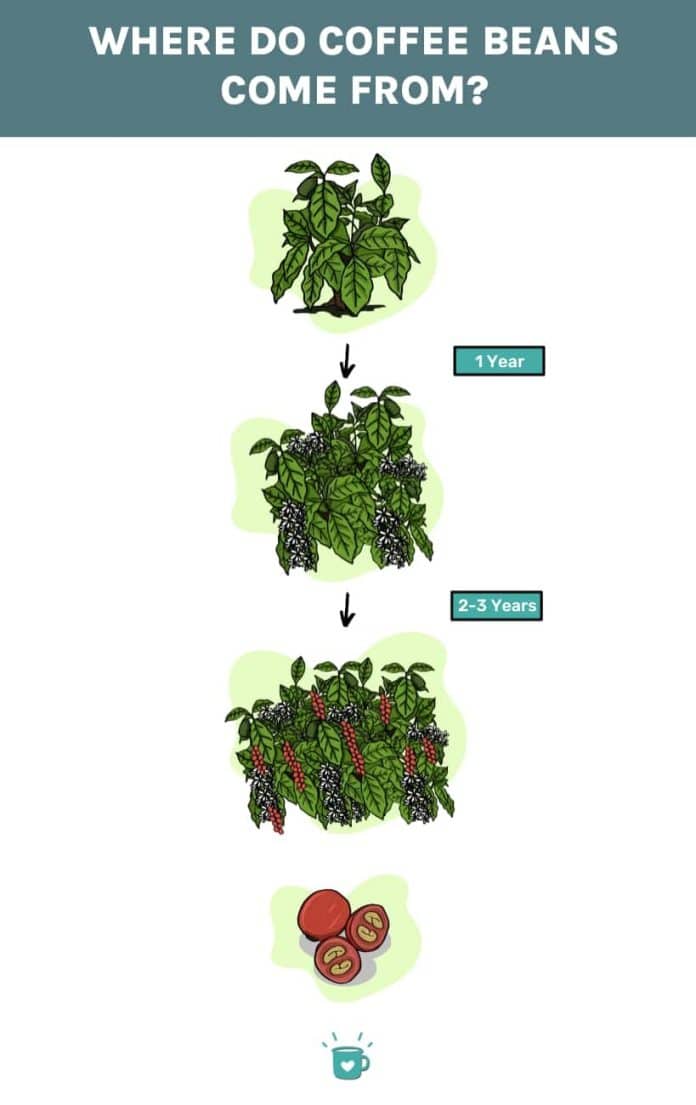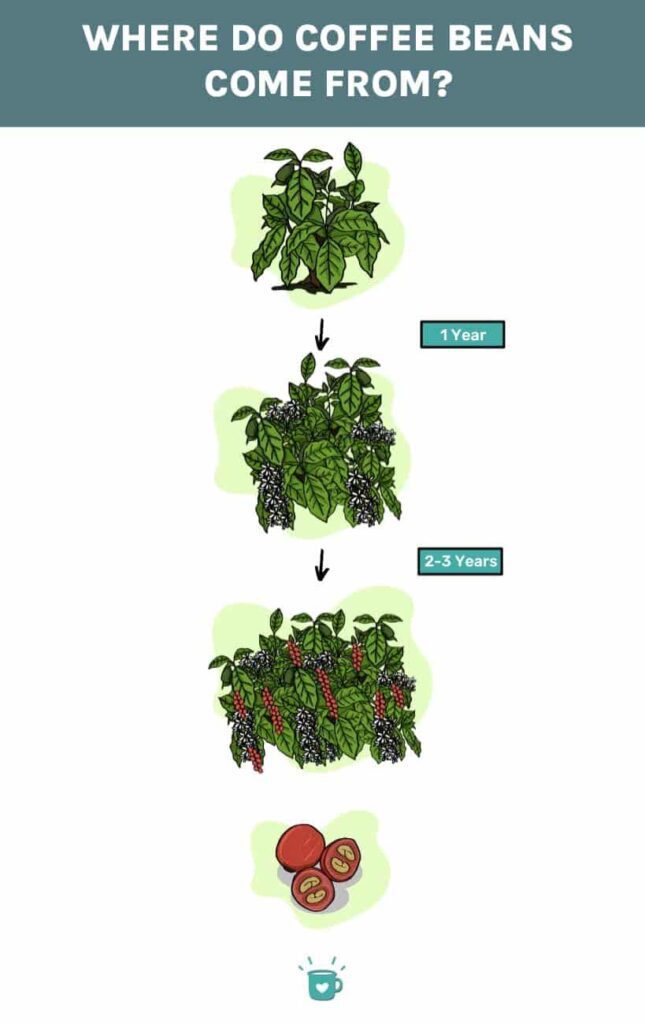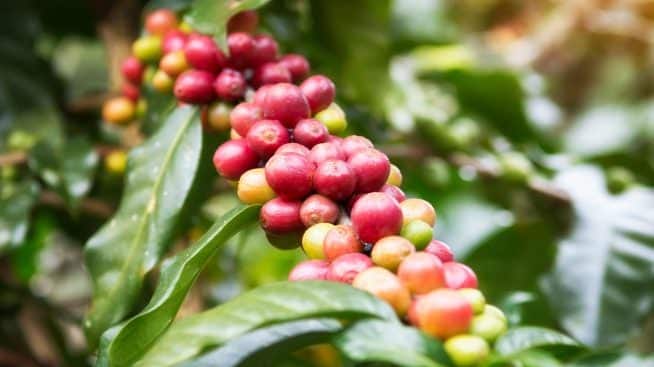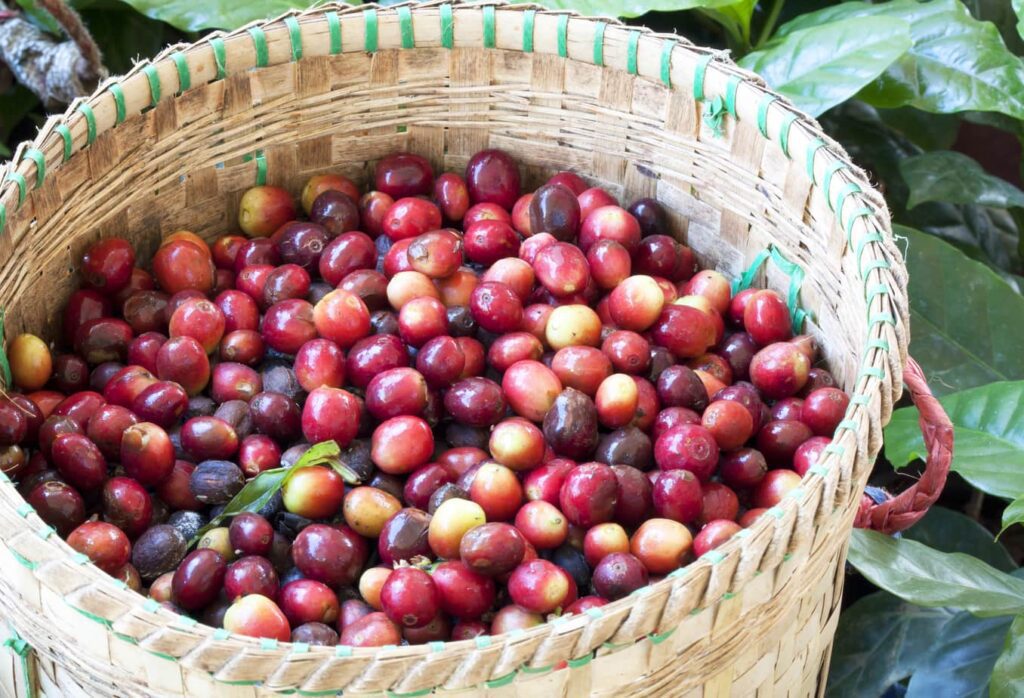Picture yourself waking up in the morning to the delightful aroma of freshly brewed coffee filling your kitchen.
Have you ever wondered what exactly coffee is and where it comes from? In this article, we will uncover the origins of this beloved beverage and explore its fascinating journey from the coffee farms to your favorite mug. So please grab a cup of joe and join us on this caffeine-filled adventure!

What is Coffee?
Coffee, a beloved beverage millions of people enjoy worldwide, is a dark, aromatic, and energizing drink made from the roasted seeds of the Coffea plant.
This evergreen shrub is native to tropical regions of Africa and belongs to the Rubiaceae family. Coffee beans are typically ground and brewed, producing a flavorful and stimulating beverage that has become integral to many cultures and daily routines.
Definition of Coffee
Coffee is a beverage made from the roasted seeds of the coffee plant. The seeds, commonly called coffee beans, are cultivated, harvested, processed, and then roasted before brewing. Once brewed, coffee can be enjoyed in various forms, such as espresso, drip coffee, or cappuccino, each offering its unique flavor profile and intensity.
Types of Coffee
Coffee enthusiasts enjoy exploring various types of coffee, each with its distinct characteristics and nuances. Some popular types of coffee include:
- Arabica: Known for its smooth and flavorful profile, Arabica beans are the most commonly consumed and cultivated species. They have a delicate acidity and a wide range of flavors, making them highly sought after by coffee connoisseurs.
- Robusta: Robusta beans are widely used in the production of instant coffee due to their higher caffeine content and more robust, bitter taste. They are also more disease-resistant and easier to cultivate than Arabica beans.
- Specialty Coffee: This term refers to high-quality coffee made from meticulously handpicked ripe cherries, carefully processed, and expertly roasted to preserve the intrinsic flavors and aromas of the beans. Specialty coffee often comes from specific regions known for their exceptional coffee production.
History of Coffee
Origins of Coffee
The origins of coffee can be traced back to Ethiopia in the 9th century when the energizing effects of the Coffea plant were first discovered. According to legend, a goat herder named Kaldi noticed his goats becoming more lively after consuming the red berries of the Coffea plant. Intrigued, he tried the berries himself and experienced a newfound vigor. This discovery led to the cultivation and consumption of coffee in the region.
Spread of Coffee Cultivation
Coffee cultivation gradually spread from Ethiopia to the Arabian Peninsula, gaining popularity as a stimulating beverage among Sufis. The Arabs were the first to cultivate coffee on a larger scale and to roast the beans. Coffee’s reputation as a refreshing drink made its way to the Islamic world by establishing the first coffeehouses in the 15th century in Cairo, Mecca, and Istanbul.
Influence of Coffee on Culture
Coffee had a profound impact on various cultures throughout history. In Europe, introducing coffee sparked a cultural revolution, replacing heavy alcohol consumption with the social ritual of drinking coffee. Coffeehouses became intellectual and social hubs, nurturing the birth of new ideas and fostering discussions among artists, philosophers, and writers. The coffeehouse culture gave rise to the Enlightenment era and played a significant role in shaping European society.
Coffee Plant
Species of Coffee
There are over 100 species of the Coffea plant, but the two most commercially important species are Coffea arabica and Coffea canephora, commonly known as Arabica and Robusta, respectively. Arabica accounts for most coffee production worldwide due to its superior flavor, while Robusta is valued for its higher caffeine content and hardiness.
Growth Requirements
Coffee plants thrive in tropical climates with rich soil, moderate rainfall, and temperatures between 60°F (15°C) and 70°F (24°C). They require a steady supply of moisture, shade, and protection from strong winds, making mountainous regions with volcanic soil ideal for their cultivation. Adequate altitude and specific microclimates contribute to different regions’ nuanced flavors of specialty coffees.
Coffee Growing Regions
Major Coffee-Producing Countries
Coffee is cultivated in several regions around the world, with some of the top coffee-producing countries including:
- Brazil: As the largest producer of coffee, Brazil accounts for a significant portion of global coffee production. Brazilian coffee is known for its mild and nutty flavors and is often used in blends.
- Colombia: Renowned for its high-quality Arabica beans, Colombia produces coffee with a well-balanced flavor and pronounced acidity. Colombian coffee is admired for its smoothness and delightful aroma.
- Ethiopia: The birthplace of coffee, Ethiopia produces a diverse range of Arabica coffees renowned for their fruity, floral, and wine-like flavors. Ethiopian coffee is often associated with complex and vibrant taste profiles.
- Vietnam: Known for its robust coffee production, Vietnam is the second-largest coffee producer globally. Vietnamese coffee is characterized by its robust and bold flavor and is commonly used in traditional Vietnamese iced coffee.
- Costa Rica: This Central American country is celebrated for its high-quality Arabica coffee, known for its bright acidity, clean taste, and pleasant citrus and chocolate notes.
Unique Characteristics of Different Regions
Coffee crops grown in different regions exhibit unique characteristics influenced by soil composition, altitude, climate, and farming techniques. These distinct qualities are often referred to as “terroir” and are cherished by coffee enthusiasts. For example, Central American coffees are known for their bright acidity and nutty undertones, while East African coffees offer vibrant acidity, floral aromas, and fruity flavors. South American coffees are typically well-balanced, with caramel and chocolate notes. These regional distinctions contribute to the rich tapestry of flavors found in coffee.
Coffee Processing
Harvesting Coffee Beans
Harvesting coffee beans involves handpicking the ripe cherries when they have reached their maximum sweetness. This selective harvesting ensures the highest quality beans, as only the cherries at the peak of ripeness are chosen. Handpicking also allows farmers to avoid unripe or overripe cherries, enhancing the flavor profile of the final product.
Methods of Coffee Bean Processing
After harvesting, coffee beans undergo processing to remove the outer layers of fruit and parchment, revealing the inner coffee beans. There are three primary methods of coffee bean processing:
- Washed (or Wet) Processing: The pulp is mechanically removed from the cherries before fermentation. The beans are soaked in water to remove residue, resulting in a clean and bright flavor profile often associated with specialty coffees.
- Natural (or Dry) Processing: In this traditional method, the cherries are dried in the sun or on raised beds, allowing the fruit to ferment and dry around the beans naturally. Natural processing imparts fruity, wine-like flavors and a heavy body to the coffee.
- Honey (or Pulped Natural) Processing: This method involves removing the skin and some of the pulp from the cherries leaving some mucilage intact. The beans are then dried, resulting in a coffee with a unique sweetness and a creamy mouthfeel.
Roasting and Brewing Coffee
The Art of Roasting
Roasting coffee is a proper art form where green coffee beans are transformed into the familiar brown beans we know and love. The roasting process involves carefully controlling temperature and duration to develop desired flavors and aromas. Roasters employ their expertise to balance preserving the beans’ unique characteristics and achieving the desired roast level.
Different Roast Levels
Coffee can be roasted to various levels, each offering distinct flavor profiles:
- Light Roast: Light roasts retain the most natural flavors of the coffee, resulting in a tangy and vibrant cup. The beans are generally light brown and have a higher acidity and a floral or fruity aroma.
- Medium Roast: Medium roasts strike a balance between acidity and body, showcasing the flavors of the coffee without overpowering them. The beans have a medium-brown color and offer a more rounded and balanced cup.
- Dark Roast: Dark roasts produce intense flavors with lower acidity and a fuller body. Beans are dark brown or black and often have bittersweet notes and a smoky aroma.
Methods of Brewing Coffee
There are numerous ways to brew coffee, allowing each individual to find their preferred method and taste. Some popular brewing methods include:
- Drip Brewing: Drip brewing, or pour-over, involves pouring hot water over coffee grounds in a filter, allowing it to drip into a decanter or mug slowly. This method emphasizes clarity of flavor and aroma.
- Espresso: Espresso is made by forcing hot water through finely-ground coffee under high pressure, extracting concentrated flavors and a rich crema. It serves as the foundation for many other coffee-based beverages.
- French Press: French press brewing utilizes immersion, where coffee grounds are steeped in hot water before being separated by pressing down a plunger to separate the grounds from the liquid. This method yields a full-bodied cup with more pronounced flavors.
- Cold Brew: Cold brew involves steeping coffee grounds in cold water for an extended period, resulting in a smooth, low-acidity beverage typically enjoyed over ice.
Flavor and Aroma of Coffee
Factors Affecting Flavor
Several factors influence the flavor and aroma of coffee, including:
- Coffee Bean Variety: Different coffee bean varieties have distinct flavor profiles, with Arabica beans often offering a more comprehensive range of flavors compared to Robusta.
- Growing Conditions: Altitude, climate, and soil composition impact the beans’ development, influencing flavor characteristics.
- Roasting Technique: The roasting process is crucial in developing specific flavors, as different roast levels bring out different qualities in the beans.
- Brew Method: The brewing method can affect the extraction of flavors from the coffee grounds, resulting in variations in taste and aroma.
Coffee Tasting Techniques
Coffee tasting, also known as cupping, is a sensory experience that involves carefully evaluating a coffee’s aroma, flavor, and body. To taste coffee effectively, one must engage their senses and follow a systematic approach, including observing the fragrance, slurping small sips, and evaluating the flavor characteristics. This mindful approach allows for a deeper appreciation of the complexities and nuances within different coffees.
Health Benefits and Risks of Coffee
Potential Health Benefits
Coffee consumption has been associated with several potential health benefits, including:
- Antioxidant Properties: Coffee contains high levels of antioxidants that help protect against oxidative stress and inflammation in the body.
- Improved Cognitive Function: The caffeine in coffee can enhance alertness and improve cognitive performance, including memory and focus.
- Reduced Risk of Certain Diseases: Some studies suggest that regular coffee consumption may lower the risk of conditions such as Parkinson’s, type 2 diabetes, liver disease, and certain types of cancer.
Considerations for Consumption
While coffee offers potential health benefits, it is essential to keep specific considerations in mind:
- Sensitivity to Caffeine: Individuals sensitive to caffeine may experience adverse effects such as anxiety, jitteriness, or disrupted sleep patterns. It is essential to monitor caffeine intake and choose decaffeinated options if necessary.
- Moderation: Like any beverage, excessive consumption of coffee can have adverse effects, such as increased heart rate, digestive issues, or sleep disturbances. Consuming coffee in moderation and being mindful of personal tolerance levels is recommended.
- Individual Differences: It is important to remember that the effects of coffee can vary from person to person. Each individual may have different sensitivities or reactions to caffeine, and it is crucial to listen to your body and make choices accordingly.
Coffee Culture and Traditions
Coffeehouses and Cafés
Coffeehouses and cafés have played a significant role in shaping social interactions and fostering a sense of community. These establishments have provided spaces for people to gather, engage in stimulating conversations, and savor the pleasures of coffee. Coffeehouses have historically been hubs for artists, intellectuals, and activists, encouraging the exchange of ideas and nurturing creativity. Today, coffeehouses and cafés serve as meeting places and cultural landmarks in many communities worldwide.
Coffee in Social Interactions
Coffee is often associated with social interactions, from intimate conversations with friends to business meetings and first dates. Sharing a coffee can create a sense of connection and provide a comforting backdrop for various social engagements. It catalyzes meaningful conversations, offering a pause from the busyness of life and an opportunity to savor the moment.
Environmental and Social Impact of Coffee
Sustainable Coffee Production
As the demand for coffee continues to rise, it is crucial to prioritize sustainable coffee production. Sustainable practices ensure environmental conservation, protect biodiversity and promote the well-being of coffee farmers and their communities. This includes adopting organic farming methods, reducing water usage, preserving ecosystems, and implementing fair labor practices throughout the coffee supply chain.
Fair Trade Practices
Fairtrade initiatives aim to address the economic inequalities in coffee production by ensuring that farmers receive fair compensation for their labor. Fairtrade practices prioritize transparent supply chains, guaranteeing that farmers and workers receive fair wages, have safe working conditions, and promote community development. By supporting fair-trade coffee, consumers can contribute to a more equitable and sustainable coffee industry.
In conclusion, coffee is a remarkable beverage with a rich history and cultural significance. From its origins in Ethiopia to its global spread, coffee has become deeply intertwined with various traditions and social interactions. The distinct flavors and aromas found in different coffee-growing regions highlight the complexity and diversity of this beloved drink. As we continue to explore the world of coffee, it is crucial to appreciate its impact on the environment, prioritize sustainability, and support fair trade practices. So, grab a cup of your favorite brew, savor the flavor, and enjoy the journey coffee takes you on. Cheers!








































